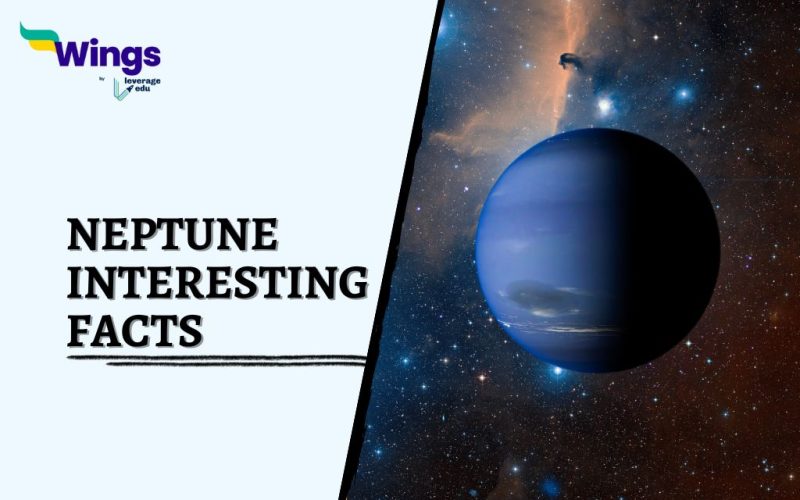The trick to remembering the order of planets in the solar system is to remember this phrase, “My Very Excellent Mom Just Served Us Noodles”. In this phrase, the first alphabet of every word stands for a planet. Evidently, Neptune is the last planet and also the farthest planet. Some interesting facts about Neptune include that it has powerful winds, it looks blue in colour and is wider than the Earth. Students interested in the outer space world and solar system are forever curious about this planet and its unique characteristics. To help them learn more, here is a blog full of Neptune interesting facts for students.
Table of Contents
Neptune Interesting Facts
Neptune is one of the eight planets in our solar system. Its blue appearance is full of many interesting facts such as:
1. Neptune is named after the Roman god of the sea.
2. Neptune is the eighth planet in our solar system.
3. It is the most distant planet in the solar system.
4. Neptune is the only planet which is not visible to the naked human eye.
5. Neptune was discovered in 1846 through mathematical calculations.
6. In 2011, Neptune completed its first 165-year orbit.
7. The temperature and pressure of Neptune are so volatile that organisms may not be able to adapt to the planet.
8. Neptune is about four times wider than Earth.
9. Neptune is 30 astronomical units away from the Sun.
10. It takes about 16 hours for Neptune to rotate or take a spin once.
11. Neptune has 5 main rings and 4 prominent ring arcs.
12. These rings contain at least 20% dust.
13. Neptune is one of the two ice giants in the outer solar system.
Fun Facts About Neptune
Neptune’s core and atmosphere are made of unusual components. Even the conditions on this planet are far more different than that on Earth. From intense winds to icy surfaces, here are some amazing fun facts about Neptune.
1. 80% or more of the planet’s mass is made up of a hot dense fluid of icy materials like water, methane, and ammonia.
2. Neptune does not have a solid surface.
3. Neptune’s atmosphere is made up of hydrogen, helium, and a small amount of methane.
4. It has the strongest winds in the solar system.
5. It is also the coldest planet.
6. NASA’s Voyager 2 is the only spacecraft that has ever visited Neptune.
Facts About Neptune Moons
Contrary to popular belief, not every planet in the solar system has a moon. The inner planets, Mercury and Venus are the two big examples. But what do you know about Neptune’s moons? Here are some facts to understand better:
1. Neptune has 16 known moons.
2. Triton is Neptune’s largest moon. It was discovered by William Lassel.
3. Since Neptune is named after the Roman god of the sea, its moons are also named after lesser sea gods and nymphs in Greek mythology.
Quiz on Facts About Neptune
Now that you have read some interesting facts about Neptune, how about attempting a few quiz questions to test your knowledge? Make sure to read each question carefully and only then select the correct answer from the options. Once you have attempted all the questions, use the Answer Key provided at the end to calculate your score.
1. Which of the following statements is true about Neptune’s name?
| a) it is named after the Roman god of the sea |
| b) it is named after the Roman god of the sun |
| c) it is named after the Roman god of the air |
2. How many moons does Neptune have?
| a) 15 |
| b) 16 |
| c) 17 |
3. Which of the following statements is true about Neptune’s temperature?
| a) It is the coldest planet |
| b) It is the hottest planet |
| c) The temperature remains neutral and suitable for living beings |
4. Identify Neptune’s largest moon.
| a) Aron |
| b) Maxon |
| c) Triton |
5. Which is the only spacecraft to ever visit Neptune?
| a) Chandryaan |
| b) Aditya-L1 |
| c) Voyager 2 |
6. When was Neptune discovered?
| a) 1846 |
| b) 1847 |
| c) 1848 |
Answer Key
| 1. a | 4. c |
| 2. b | 5. b |
| 3. a | 6. a |
Interesting Blogs
FAQs
5 facts about Neptune are that it is named after the god of the sea, it is the coldest planet, it is also called the Blue Giant for its vivid colour, it has 16 known moons, and lastly, Neptune might not be able to support life.
Neptune is known as the Blue Giant due to its large size and vivid colour. It is also the coldest and the most distant planet of our solar system.
Neptune is made up of hydrogen, helium, and methane. The methane present in Neptune absorbs the red light coming from the sun but reflects the blue light from the Sun back into space. This makes it appear blue in colour.
Hope you enjoy reading these interesting Neptune facts. If you want to know more about topics like this, then visit our Interesting Facts and General Knowledge page.
 One app for all your study abroad needs
One app for all your study abroad needs













